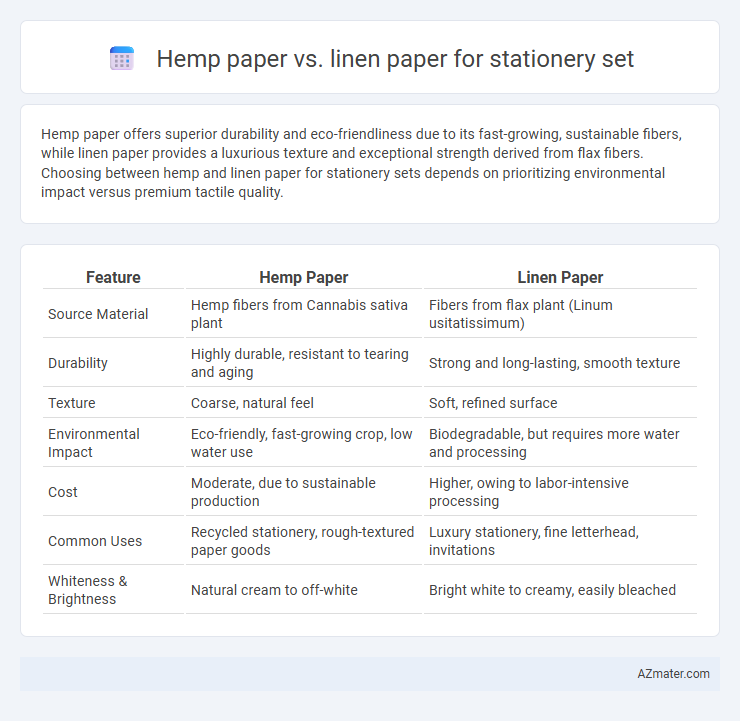Hemp paper offers superior durability and eco-friendliness due to its fast-growing, sustainable fibers, while linen paper provides a luxurious texture and exceptional strength derived from flax fibers. Choosing between hemp and linen paper for stationery sets depends on prioritizing environmental impact versus premium tactile quality.
Table of Comparison
| Feature | Hemp Paper | Linen Paper |
|---|---|---|
| Source Material | Hemp fibers from Cannabis sativa plant | Fibers from flax plant (Linum usitatissimum) |
| Durability | Highly durable, resistant to tearing and aging | Strong and long-lasting, smooth texture |
| Texture | Coarse, natural feel | Soft, refined surface |
| Environmental Impact | Eco-friendly, fast-growing crop, low water use | Biodegradable, but requires more water and processing |
| Cost | Moderate, due to sustainable production | Higher, owing to labor-intensive processing |
| Common Uses | Recycled stationery, rough-textured paper goods | Luxury stationery, fine letterhead, invitations |
| Whiteness & Brightness | Natural cream to off-white | Bright white to creamy, easily bleached |
Introduction to Hemp and Linen Paper
Hemp paper, made from the bast fibers of the Cannabis sativa plant, offers remarkable durability and eco-friendly attributes due to its fast growth and minimal need for pesticides. Linen paper, derived from flax fibers, is prized for its smooth texture and durability, often used in high-end stationery for a luxurious feel. Both materials provide sustainable alternatives to traditional wood pulp paper, with hemp excelling in strength and flax in softness, making each suitable for premium stationery sets.
Historical Background of Hemp and Linen Paper
Hemp paper, dating back to ancient China around 105 AD, was one of the earliest forms of paper and became widely used in Europe during the Middle Ages due to its durability and resistance to aging. Linen paper, derived from flax fibers, has a rich history in Europe where it was favored from the 13th century onward for its smooth texture and archival quality, often used in important documents and manuscripts. Both hemp and linen papers have deep-rooted historical significance, with hemp valued for its robustness and linen prized for its fine quality in traditional stationery.
Raw Material Sources: Hemp vs Linen
Hemp paper, derived from the fibrous stalks of the Cannabis sativa plant, offers a sustainable raw material source due to its rapid growth cycle and minimal pesticide requirements. Linen paper is made from the flax plant's fibers, known for their strength but involving a longer cultivation period and more intensive processing. Both fibers provide durability, yet hemp's eco-friendly cultivation makes it a preferred choice for environmentally conscious stationery sets.
Production Processes Compared
Hemp paper production utilizes fast-growing hemp fibers processed through eco-friendly chemical pulping and mechanical refining, resulting in durable, sustainable sheets with minimal environmental impact. Linen paper manufacturing involves extracting fibers from flax plants, followed by retting, scutching, and beating stages to create a smooth and high-quality texture ideal for luxurious stationery. Both processes emphasize fiber preparation; however, hemp's shorter processing time and lower water usage give it a distinct advantage in green manufacturing efficiency.
Environmental Impact and Sustainability
Hemp paper offers superior environmental benefits compared to linen paper due to its rapid growth cycle and minimal need for pesticides or herbicides, significantly reducing deforestation and chemical pollution. It requires less water and energy during production, enhancing its sustainability profile and lowering its carbon footprint. Unlike linen paper, which is derived from cotton fibers with higher resource consumption, hemp paper's durability and recyclability make it an eco-friendly choice for stationery sets focused on sustainability.
Texture and Appearance Differences
Hemp paper features a coarse, natural texture with visible fibers, giving stationery a rustic and eco-friendly appearance ideal for artistic or environmentally-conscious branding. Linen paper offers a smooth yet subtly textured surface with fine horizontal and vertical lines, creating a sophisticated, classic look favored for formal invitations and premium stationery sets. The distinctly tactile feel of hemp contrasts with the refined, elegant finish of linen, influencing the overall sensory experience and visual impression of the stationery.
Durability and Longevity for Stationery
Hemp paper offers superior durability and resistance to wear, making it ideal for long-lasting stationery sets that withstand frequent handling and environmental exposure. Linen paper, known for its high-quality texture and strength, also provides excellent longevity but may be more susceptible to creasing compared to hemp. Choosing hemp paper ensures enhanced tear resistance and archival qualities, making it a preferred option for durable stationery.
Ink Compatibility and Writing Experience
Hemp paper offers excellent ink absorption with minimal bleed-through, making it ideal for fountain pens and gel inks, whereas linen paper provides a smoother surface that enhances ink flow and sharpness, especially with ballpoint and rollerball pens. Hemp's slightly textured finish adds a natural grip, improving handwriting control, while linen's refined weave delivers a luxurious tactile feel that elevates the overall writing experience. Both papers excel in archival quality, but hemp's eco-friendly fibers promote durability without sacrificing ink clarity, whereas linen paper ensures consistent ink distribution for precise, professional stationery sets.
Cost Analysis: Hemp Paper vs Linen Paper
Hemp paper typically costs 10-30% more than linen paper due to higher raw material processing expenses and sustainable cultivation practices. Linen paper benefits from an established supply chain and lower production costs, making it more affordable for large-scale stationery sets. While hemp paper offers superior durability and eco-friendliness, budget-conscious buyers often prefer linen paper for cost-effective stationery solutions.
Choosing the Ideal Paper for Your Stationery Set
Hemp paper offers exceptional durability and eco-friendly attributes due to its fast-growing, renewable fibers, making it ideal for sustainable stationery sets. Linen paper provides a luxurious texture and archival quality with its refined cotton fibers, appealing to users who prioritize premium feel and longevity. Choosing the ideal paper depends on balancing environmental impact with tactile experience, ensuring your stationery set aligns with both aesthetic and ethical values.

Infographic: Hemp paper vs Linen paper for Stationery set
 azmater.com
azmater.com